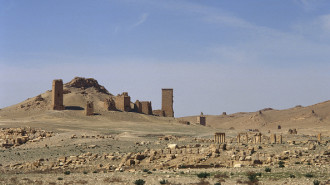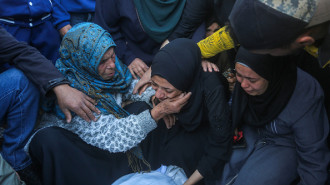Palestinian photographer brings towns lost in Nakba to life on walls of refugee camps
As soon as you enter Madaris street in Balata refugee camp, to the east of Nablus in the occupied West Bank, your gaze is drawn to the right-hand wall of the street - now adorned with 30 depictions of villages and towns that were purged of Palestinian residents during the creation of the state of Israel in 1948.
In 17 refugee camps across the West Bank, Palestinian photographer Ahmed al-Bazz has brought to life images of historic Palestine to the descendants of those who were expelled during the Nakba.
The Palestinian Nakba is mostly associated with Palestinian refugeehood and refugee camps, 20 of which are located in the occupied West Bank.
Their residents are descendants of those who were expelled from towns, villages and cities in what is now Israel, such as Haifa, Jaffa, Lod, and Ramleh. Among the are people who were alive during the 1948 catastrophe.
معرض صور في #مخيم_بلاطة بنابلس للقرى الفلسطينية المهجرة عام 1948 للمصور الفلسطيني أحمد البظ
— بوابة اللاجئين الفلسطينيين (@refugeesps) May 15, 2023
تصوير/محمد منصور#نكبة_75 #Nakba75 pic.twitter.com/74e8szI6u2
“To reach as many people as possible - the people for whom these images mean so much - we placed the images where everyone will see them, where everyone passes by on foot in the camps,” al-Bazz told The New Arab's sister site Al-Araby Al-Jadeed.
“It’s so important that these images are in the open air. People spend less and less time going to cultural centres or official institutions to engage with art and culture,” he continued.
“People live their lives on the internet. I wanted to engage in the real world,” said al-Bazz.
The Nablus-born Palestinian is a photographer and producer whose work focuses on questions of Palestinian statehood - especially the right to return and West Bank refugees.
Al-Bazz’s work has also helped him build bridges with Palestinian citizens of Israel, who helped him create a picture of the Palestine that was lost, visiting abandoned Palestinian towns and re-learning erased histories.
“Most inhabitants of the camps cannot visit their ancestral homes - but I want them to get to know them, through these images we can go there together,” explained al-Bazz.
![Most Palestinian refugees will never see their ancestral homes in the flesh [al-Araby al-Jadeed]](/sites/default/files/styles/image_345x195/public/2023-05/33%20%282%29_0.jpg?h=66a2249f&itok=XmNtiBXs)



 Follow the Middle East's top stories in English at The New Arab on Google News
Follow the Middle East's top stories in English at The New Arab on Google News

![A group of Palestinians, foreign and Israeli activists gather to participated in an olive picking event on the land in the town of Battir, which is under threat of confiscation by Israel in Bethlehem, occupied West Bank on 8 November 2024. [Getty]](/sites/default/files/styles/image_330x185/public/2182930803.jpeg?h=199d8c1f&itok=__0LgGsa)
